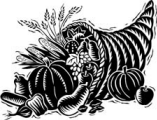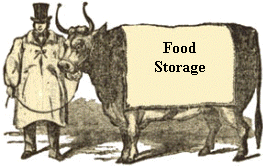Learning to store and use basic food, along with other necessities will help you be a self - sustaining Southerner. No matter what situation you find yourself encountering, whether it be loss of work, war, civil unrest, tornado, hurricane, fire or flood - start stocking up now!
When designing and building your food-storage area, you need to minimize areas where insects and rodents can hide. Seal all cracks and crevices. Eliminate any openings that insects or rodents may use to gain entrance to your storage area. Food should only be stored in food-grade containers. A food-grade container is one that will not transfer non-food chemicals into the food and contains no chemicals that would be hazardous for your health. Some examples of WHAT not to use are trash or garbage bags, paint or solvents cans, industrial plastics that have been used for non-food purposes. Package dried foods in airtight, moisture-proof, insect-proof containers such as glass jars or plastic freezer boxes or bags. Metal cans with tight fitting lids can be used if dried food is first placed in a plastic bag. Package dried foods in small amounts because once the food is open, the food can absorb moisture from the air and quality will
soon deteriorate. Low storage temperatures extend shelf life. Exposure to humidity or air decreases shelf life. If packaged correctly, food stored at below 60 degrees will maintain good quality for about one year.
Grills and camp stoves should always be used outdoors due to carbon monoxide poisoning.
Foods recommended for storage
- Water - one gallon per person per day for drinking, cooking and personal use
-
Ready-to-eat canned foods - vegetables, fruits, beans, meat, fish, poultry, pasta
- Soups - canned or dried soups in a cup
- Smoked or dried meats - commercial beef jerky
- Dried fruits and vegetables - raisins and fruit leather
- Juices (vegetable and fruit) - bottled, canned or powdered
- Milk - powdered, canned, evaporated
- Staples - sugar, salt, pepper, instant potatoes, rice, coffee, tea, cocoa mix
- Ready to eat cereals, instant hot cereals, crackers, hard taco shells
- High energy foods - peanut butter, jelly, nuts, trail mix, granola bars
- Cookies, hard candy, chocolate bars, soft drinks, other snacks
Water is free and easy to store. Be sure that you store some sort of water purifier, Clorox, or GSE (Grapefruit Seed Extract) to kill the bacteria, parasites, fungus, and viruses that can infect your water supply. And remember that the best foods to store are the basics - beans, grains, and sprouting seeds. They also happen to be the cheapest and the easiest to store!
Store one or two manual can openers with your emergency food supply. Canned foods can be heated indoors using canned heat (such as Sterno), charcoal grills, or camp stoves which could be used outside.
Optimum Length of Storage for Quality and Nutrition |
Examples: | | Fish, canned | 18 months | | Canned potatoes | 30 months | | Dehydrated potatoes | 30 months | | Canned fruits and vegetables | 24 months | | Canned fruit juice | 24 months | | Canned vegetable juice | 12 months | | Pickles | 12 months | | James and jellies | 18 months | | Rice, dried | 24 months | | Cornmeal | 12 months | | Pasta, dried | 24 months | | Cold breakfast cereal | 12 months | | Prepared flour mixes |
8 months | | Packaged dry beans, peas, and lentils | 12 months | | Canned evaporated milk | 12 months | Dry milk products
Storage Guidelines | 24 months |
Use storage areas that are well ventilated, clean, dark, dry, and cool. If your conditions are less satisfactory, rotate contents more frequently than recommended. Even though space may be limited, there are usually "hidden areas" for storage. Use your imagination! Do not place food storage containers on or against cement or dirt floors and walls. Place pieces of wood between the storage containers and the floor or wall to provide ventilation and protect against moisture. Keep stored food away from products that may affect the flavor of the food. Rotate and use food storage items regularly. Date food items as you purchase or can them, then store new supplies of food at the back of the shelves, moving earlier purchases forward to be used first. Do not go into debt! Acquire food items gradually. At the very least, save a few dollars a week for storage items. Using the basic foods in day-to-day menus can cut food costs and allow you to purchase more supplies. Or, as a family, give up some of the nonessentials for a short time until you can accumulate additional foods. Through prayer and concerted effort, you can work out a food storage plan that will provide you with security and peace of mind.
 |
Church of Jesus Christ Latter-day Saints
Use the following calculator to figure the minimum food storage amounts for your family. The amounts are based on the recommendations listed in the
Church's Home Production and Storage manual. These are only recommendations. You will need to determine what you should store for your family. |
